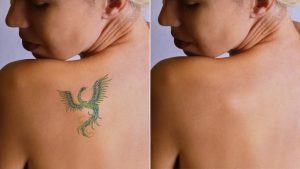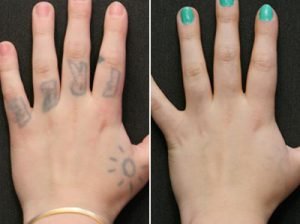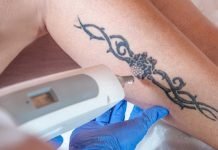Tattoo Removal Recovery, Tips for Better Result
Tattoo Removal Recovery, Tips for Better Result
Tattoo removal recovery involved physically scraping away the ink, which unsurprisingly damaged the skin, but now we have far more sophisticated methods.
The current standard for tattoo removal is laser treatment. The most common type of laser treatment in Delhi uses equipment called the Q-switched laser.
Which pulses light rapidly to dissolve the tattoo pigments without serious side effects.
Tattoo removal sessions typically last between 15 and 30 minutes. How many sessions it takes to remove a tattoo varies on its size, location and colouration.
Generally, 3 to 7 sessions scheduled a month and a half to two months apart will ensure complete removal of a tattoo.
While laser tattoo removal in Delhi treatment has minimal risks, it is important to know proper tattoo removal aftercare.
Here are some helpful tips for making the laser tattoo removal recovery process more faster and more effective.
Why do people change their minds?
- The tattoo might no longer hold the same emotional significance it did when you first got it.
- Maybe the quality of the tattoo is not what you expected, or perhaps the quality did not age well.
- You could feel your personality or circumstances have changed, and the tattoo no longer reflects who you are.
- Although taboos around tattoos are changing. You might be concerned about how the ink might affect your professional life.
Whatever the reason if you are no longer happy with your tattoo, you do not have to live the rest of your life with it on your skin. Successful tattoo removal is a viable option.
The Laser Tattoo Removal Recovery Process:
As you undergo your laser tattoo removal sessions, you will want to know what to expect as you move through recovery. Here are a few things to expect during the treatment.
Discomfort:
The laser tattoo removal process will not be painless. However, with our extensive experience, we have developed a unique numbing technique that prepares the upper layers of skin to low the discomfort.
This method is very safe and is localized to the treated area only. By going through the process ourselves, that is how we figured out this numbing technique.
With the experience and training that we have, we will make each treatment as comfortable and quick as possible and the results will be great.
After the treatment, you may experience a few uncomfortable laser tattoo removal side effects such as redness, blistering, swelling, scabbing, itching and small amounts of bleeding.
These minor symptoms will likely only last a few days after each session. In the interim, you can soothe the discomfort with an ice pack.
You may notice the blisters will lead to skin peeling that can last up to two weeks after a laser treatment session.
You will need to wait for 6 to 8 weeks between each session to allow your body to dispose of the tattoo ink the laser has dissolved.
This time frame will be determined when we are checking you out and scheduling you are following up the appointment.

Skin Discoloration:
During the treatment of laser tattoo removal recovery process, you will likely notice some temporary skin discolouration.
As the laser breaks up the ink, the upper layer of your skin will likely turn a shade of white.
This side effect is known as frosting and will change as the skin peels off during the recovery process between the treatment sessions.
Hyperpigmentation and hypopigmentation are other potential side effects to keep in mind. Hyperpigmentation is a darkening of the skin.
The laser’s pulses of light waves can affect the natural colour of your skin. People with darker skin tones are more likely to experience hyperpigmentation.
Hypopigmentation is a lightening of the skin’s natural colour, A side effect more common in people with lighter skin tones.
In most cases, the skin will return to its natural colour within six months to a year following your final treatment.
But it is possible for hyperpigmentation and hypopigmentation to be permanent.
Expectations:
During the recovery process, it is important to manage your expectations. Laser tattoo removal is an effective and best treatment, but the results are sometimes not perfect.
The type of ink in your tattoo, its size and its location can mean varying results. For example, black colour on lighter skin is typically very easy to remove.
On the other hand, green and purple ink can be very difficult to remove from any skin tone.
Larger tattoos will take longer to remove, and the larger surface area may make it more difficult to remove the tattoo completely.
You should also know tattoos located farther down on your arms and legs may be more difficult to remove completely.
The farther away from your heart, the poorer the circulation. Tattoos removed from areas like the ankle may also take longer to recover due to circulation issues.
Your tattoo will be gone or nearly gone after you complete your sessions, but keep in mind results will vary.

Tips for Speeding up the Recovery Process:
Proper laser tattoo removal recovery and aftercare will help ensure you have a smooth and quick recovery.
Prep your immune system for tattoo removal recovery:
Your immune system plays a vital role in any sort of recovery process, and the same is true of laser tattoo removal recovery.
In preparation for your treatment sessions, focus on eating nutritious foods and exercising. Adding those two things to your routine will help keep your body healthy and ready to help you heal.
Try immune-boosting foods like citrus fruits, which have lots of vitamin C, or ginger, which has anti-inflammatory properties.
Proper cleaning for tattoo removal recovery:
Proper cleaning of the treated area goes a long way toward preventing infection, Which is a big stumbling block on the road to recovery.
Each day, clean the area with cool water and pat it dry. Avoid rubbing the area, as this can further irritate the tender skin.
You should also apply an antibiotic ointment to the area, particularly any blisters that have burst.
Cover it with a clean bandage during the first three days after a treatment session to provides further protection against potential infection.
Topicals for tattoo removal recovery:
Once you have gotten past the three-day mark, You can use a variety of different topicals to help achieve faster recovery from laser tattoo removal in Delhi.
Vitamin E oil or hydrocortisone cream can help you manage irritating symptoms like itching.
If you give in to the temptation to scratch, you can prolong skin irritation and increase the likelihood of scarring.
Soothing topicals can help prevent scarring from laser tattoo removal. It is also important to remember to wear sunscreen on the area for up to three months after your final treatment.
Remember, wearing sunblock during any prolonged period in the sun is a good habit to form.
Cool compresses for tattoo removal recovery:
Swelling and redness are common side effects of laser tattoo removal. If you are experiencing inflammation, it can be tempting to touch or pick at the treated area.
Instead, use a cool compress to help reduce inflammation, which can be particularly helpful for the first day following a treatment session.
You can use things like a cool, damp cloth, an ice pack or a bag of frozen vegetables from your freezer.
After you are done using the cool compress of your choice, remember to properly clean and dry the area.
Avoid unnecessary stress for tattoo removal recovery:
Stress can severely impact our ability to heal the area. While you are recovering, try to stay calm and levelheaded.
You can go about your daily life, but do your best to avoid overly stressful situations. Maybe you can even treat yourself to some great relaxation techniques like a long walk or a message.
Whatever stress relief and management techniques you like best, this recovery period is a great time to use them for faster recovery.
Consider taking a break from smoking for tattoo removal recovery:
It is no secret smoking is an unhealthy habit, but it can affect your body in surprising ways. no doubt.
Smoking can reduce the chances of effective tattoo removal over 10 sessions by approximately 70 per cent, so stop smoking.
Smoking causes your blood vessels to constrict, but you need good, strong circulation for your body to clear the pigments from the tattoo effectively.
If you do smoke, try to stop or reduce consumption during your treatment period to maximize the effectiveness of the treatment.





 WhatsApp us
WhatsApp us